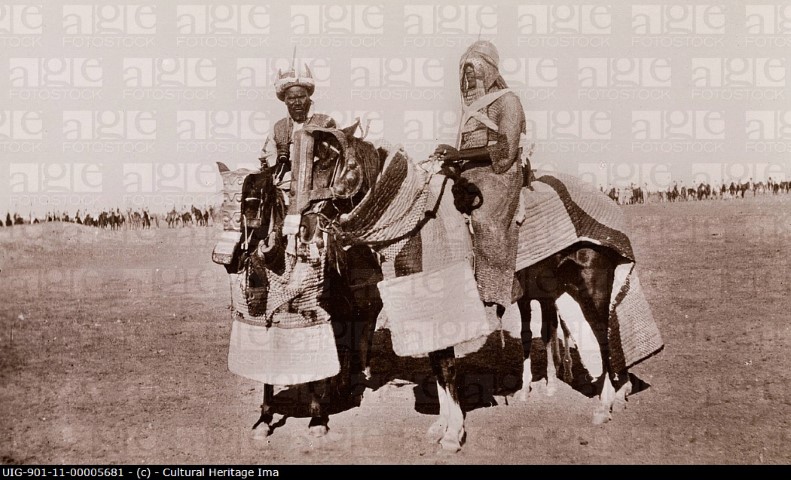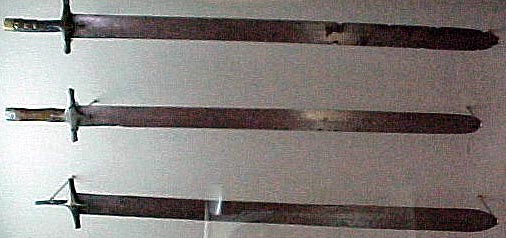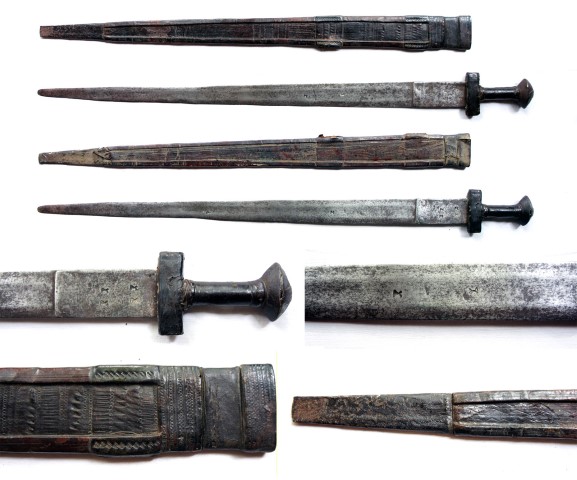I went to the San Antonio Museum of Art yesterday, It was a nice surprise "I wasn't expecting to see swords" to see 1 katana in the scabbard, 5 Shamshirs from the 17th and 18th century in excellent condition and what I thought was a European cruciform sword but it said "Sudanese" sword and some other various ancient bladed weapons.
Curiously when I next had access to the internet I looked up a bit of info and it seems to be accurate.
Here is a dramatic, probably fictional battle scene that was painted by someone, but you can see these swords in the hands of the sudanese, the guy on horseback is pretty much dressed like a classic medieval knight.
[ Linked Image ]
This is pretty much exactly what the San Antonio museum had
[ Linked Image ]
This is fascinating, clearly these Africans were using weapons that were influenced by Medieval European contact sometime in the past far before this revolution which took place from 1881 to 1899 called the Mahdist war. Almost right into the 20th century, there were cultures still using these swords.
It didn't do them very well though, they were up against machine guns and had tremendous losses.
But against bayonet charges, swords are not so far out of place.
Here is another one
That's actually a very attractive sword. Their scabbards were definitely their style though.
[ Linked Image ]
That's actually a very attractive sword. Their scabbards were definitely their style though.
[ Linked Image ]
That is a painting by Richard Caton Woodville Jr. depicting the charge of the 21st Lancers at Omdurman. The sword is called a kaskara. Another related sword type is the takouba. Check out this nice site for more: http://takouba.org/
If you are interested in the use of the sword in (British) colonial warfare in the 19th century, you should get a copy of Swordsmen of the British Empire by D.A. Kinsley.
If you are interested in the use of the sword in (British) colonial warfare in the 19th century, you should get a copy of Swordsmen of the British Empire by D.A. Kinsley.
| Quote: |
| Included is an introductory essay covering the weapons and martial arts of the sources by historical fencing instructor Matt Easton.
This is the 3rd revised and enlarged edition (2013) of the British Sword Fighters series: a unique and comprehensive collection of combat narratives of, and commentaries on, the sword fighting and fighters, swords, and swordsmanship of British conflicts from the 17th century to the 20th. With numerous illustrations. (Slightly smaller print has enabled the inclusion of much new material without increasing the number of pages that were in the previous edition.) This work includes at a massive selection of original accounts which give the reader a broad insight into what hand-to-hand combat in the age of Empire was actually like. Many of the themes covered, such as the cut and thrust debate, carry across historical periods and weapons. Numerous kinds of combat at covered, covering all the principle hand weapons of the period, including sabres, lances, bayonets, broadswords, smallswords and spears. These sources also give a great insight into other national martial traditions and weapons, including Sudanese 'dervishes', Indian swordsmen, Gurkha warriors and Zulu soldiers. |
| Christopher B Lellis wrote: |
| This is fascinating, clearly these Africans were using weapons that were influenced by Medieval European contact sometime in the past far before this revolution which took place from 1881 to 1899 called the Mahdist war. Almost right into the 20th century, there were cultures still using these swords. |
These were worn - even in not used often in battle - well into the 20th century, and possibly even the 21st.
There's no reason to suspect Medieval European influence, though, since double-edged straight swords with cruciform hilts were in wide use in the Arab world, including Egypt. The langets on the guard, which also run down the grip (the same as on typical shamshir guards), are more characteristic of Arab swords than European.
That said, some of these have European blades (often 19th century, made for trade).
Some more info on these: http://www.vikingsword.com/ethsword/kaskara/
| Timo Nieminen wrote: | ||
These were worn - even in not used often in battle - well into the 20th century, and possibly even the 21st. There's no reason to suspect Medieval European influence, though, since double-edged straight swords with cruciform hilts were in wide use in the Arab world, including Egypt. The langets on the guard, which also run down the grip (the same as on typical shamshir guards), are more characteristic of Arab swords than European. That said, some of these have European blades (often 19th century, made for trade). Some more info on these: http://www.vikingsword.com/ethsword/kaskara/ |
Those swords are too similar to at least not suspect it. I thought I was looking at a European sword that the San Antonio art museum somehow got. I've been to the Wallace collection, if that sword were part of that collection I would not have been able to recognize it as out of place, the pommel is flat, but there were Euro swords that were made like that too. I seriously doubt there is no European influence.
Thanks for that link.
Last edited by Christopher B Lellis on Sun 07 Jul, 2013 6:40 pm; edited 1 time in total
| Jonathan Hopkins wrote: | ||
| That is a painting by Richard Caton Woodville Jr. depicting the charge of the 21st Lancers at Omdurman. The sword is called a kaskara. Another related sword type is the takouba. Check out this nice site for more: http://takouba.org/
If you are interested in the use of the sword in (British) colonial warfare in the 19th century, you should get a copy of Swordsmen of the British Empire by D.A. Kinsley.
|
I will get a copy of that, thanks for the links.
I heard from a collector how hadendoa blacksmiths get the metal for the blades. Since the 19. th. Century the families begun to steal trainrails, but in the 20. th. Century they attacked trucks for the leaf springs.
Of course the story can be true but I don't know when France from the west or UK from the north begun to build railroads into the Sudan.
Of course the story can be true but I don't know when France from the west or UK from the north begun to build railroads into the Sudan.
As the owner of the takouba.org website I should probably add a few comments (thanks for linking it by the way Jonathan, I'm always happy to see it's useful). :)
Yes, Timo is correct, the influence is more likely to be Arab and Mamluk with respect to hilt of the kaskara. The main source for arms and armour flowing into Sudan was via Egypt. On the takouba side it's a similar story but with different geographical influences. For more on straight bladed Islamic sword this is a nice thread: http://www.myArmoury.com/talk/viewtopic.php?t=17520
Of course from a certain perspective there was European influence, in so much as many of the blades originated there. Both 19th century trade blade and blades from earlier periods as well.
Both kaskara and takouba are still made to this day, mainly as an accessory of traditional dress and for ceremonial use. As Henrik points out, modern steel sources are typically leaf springs from vehicles. The railway steel is also true - the British rail line to Khartoum was completed in 1899.
It's nice to see these under discussion here. Both are rather long lived types and give a fascinating window into African kingdoms such as Sennar, Darfur, the Hausa kingdoms and Bornu.
Here's a nice example held by the British Museum and attributed to a Darfur ruler from the mid 18th century.
http://www.britishmuseum.org/explore/online_t...sword.aspx
I'm also attaching a neat image of a couple of cavalrymen from Kordofan circa 1910.
 Attachment: 120.15 KB
Attachment: 120.15 KB

Yes, Timo is correct, the influence is more likely to be Arab and Mamluk with respect to hilt of the kaskara. The main source for arms and armour flowing into Sudan was via Egypt. On the takouba side it's a similar story but with different geographical influences. For more on straight bladed Islamic sword this is a nice thread: http://www.myArmoury.com/talk/viewtopic.php?t=17520
Of course from a certain perspective there was European influence, in so much as many of the blades originated there. Both 19th century trade blade and blades from earlier periods as well.
Both kaskara and takouba are still made to this day, mainly as an accessory of traditional dress and for ceremonial use. As Henrik points out, modern steel sources are typically leaf springs from vehicles. The railway steel is also true - the British rail line to Khartoum was completed in 1899.
It's nice to see these under discussion here. Both are rather long lived types and give a fascinating window into African kingdoms such as Sennar, Darfur, the Hausa kingdoms and Bornu.
Here's a nice example held by the British Museum and attributed to a Darfur ruler from the mid 18th century.
http://www.britishmuseum.org/explore/online_t...sword.aspx
I'm also attaching a neat image of a couple of cavalrymen from Kordofan circa 1910.

I was hoping to make a trip down from Dallas to San Antonio this summer, since I've never had the chance to visit the museums there; this thread is more encouragement to do so. :-)
I have both a kaskara and takouba. I just got the kaskara earlier this year and haven't yet assembled a costume for it, though I have prepared notes to do so.
http://www.forensicfashion.com/1885MahdistNasir.html
http://www.forensicfashion.com/1885MahdistNasirSword.html
[ Linked Image ]
I do have a Tuareg kit for my takouba, which I've used twice since last year. Popular with both bellydancers and camels.
http://www.forensicfashion.com/1899TuaregWarrior.html
Iain, thanks for sharing your site. I wasn't aware of it before but will make use of it going forward.
[ Linked Image ][ Linked Image ]
I have both a kaskara and takouba. I just got the kaskara earlier this year and haven't yet assembled a costume for it, though I have prepared notes to do so.
http://www.forensicfashion.com/1885MahdistNasir.html
http://www.forensicfashion.com/1885MahdistNasirSword.html
[ Linked Image ]
I do have a Tuareg kit for my takouba, which I've used twice since last year. Popular with both bellydancers and camels.
http://www.forensicfashion.com/1899TuaregWarrior.html
Iain, thanks for sharing your site. I wasn't aware of it before but will make use of it going forward.
[ Linked Image ][ Linked Image ]
Iain,
Would the Fulani warriors of Nigeria also have used cruciform swords similar to the takouba?
Thank you,
Jonathan
Would the Fulani warriors of Nigeria also have used cruciform swords similar to the takouba?
Thank you,
Jonathan
| Iain Norman wrote: |
| Yes, Timo is correct, the influence is more likely to be Arab and Mamluk with respect to hilt of the kaskara. The main source for arms and armour flowing into Sudan was via Egypt. |
The Sudan was essentially part of the Mamluk Empire at it's peak, wasn't it? The Mamluks used these straight swords for centuries, even alongside the later "Mameluke" sabers that became the US Marine Corps. dress sword. These straight double-edged swords would have been the main sidearm of the Ghulam and Mamluks who fought in the crusades.
Here's a possible European connection... Many Mamluks were Albanian, Circassian, Turk... And many Mamluks were recruited as young or fully grown adults.
Here's some pictures of some Mamluk straight swords.

Mamluk swords from Topkapi Saray - 14th to 16th C., I believe.

Mamluk straight sword. 13th to 15th C.
Mamluk Empire at start of the 15th. [ Download ]
| Jonathan Hopkins wrote: |
| Would the Fulani warriors of Nigeria also have used cruciform swords similar to the takouba? |
If they carried a sword, they most likely carried a takouba (otherwise, a double-edged straight sword or dagger of other, including local, design). Their main weapons were spears and javelins, so some might carry lance, axe, and dagger, and no sword.
| Jonathan Hopkins wrote: |
| Iain,
Would the Fulani warriors of Nigeria also have used cruciform swords similar to the takouba? Thank you, Jonathan |
Yes, as Timo already indicated, the Fulani did use the takouba. Prior to the Fulani Jihads of the early 19th century, their forces mainly consisted of infantry and archers, as their societal role with the Hausa city states they lived around was not of a class where they were part of the cavalry or other, typical takouba using elements.
After they gained power the takouba was likely one of the trappings of office that was adopted and came into more widespread use. However they were certainly exposed to and around the design long before those events.
The takouba itself covers a very wide range and number of ethnic groups, from the Tuareg, to the Hausa and Fulani, right into Northern Cameroon.
| Bennison N wrote: |
|
The Sudan was essentially part of the Mamluk Empire at it's peak, wasn't it? The Mamluks used these straight swords for centuries, even alongside the later "Mameluke" sabers that became the US Marine Corps. dress sword. These straight double-edged swords would have been the main sidearm of the Ghulam and Mamluks who fought in the crusades. Here's a possible European connection... Many Mamluks were Albanian, Circassian, Turk... And many Mamluks were recruited as young or fully grown adults. |
Yes, parts were, however states like Sennar managed to remain independent from what was then Ottoman Egypt. Certainly I think the influence from the Mamluk straight bladed designs is pretty clear on the kaskara. The main trade in blades, including the European trade blades, flowed through Cairo.
To add: one of the better books on this kind of thing is Spring's African Arms & Armour, http://www.myArmoury.com/books/item.1560983175.html
AFAIK, there are some Osprey books which cover the same content, at least partially, but I don't know about details and quality.
AFAIK, there are some Osprey books which cover the same content, at least partially, but I don't know about details and quality.
As for the fun you can have with African Viking swords, see http://www.vikingsword.com/vb/showthread.php?t=16198
| Timo Nieminen wrote: |
| As for the fun you can have with African Viking swords, see http://www.vikingsword.com/vb/showthread.php?t=16198 |
Owch, looks like somebody bought a del-tin hilted african sword! :surprised: What a scam by the supposed experts at the auction house.
| Timo Nieminen wrote: |
| To add: one of the better books on this kind of thing is Spring's African Arms & Armour, http://www.myArmoury.com/books/item.1560983175.html
AFAIK, there are some Osprey books which cover the same content, at least partially, but I don't know about details and quality. |
Yes Spring is a good overview as is "African Knights" by Cairns, although it is quite a light introductory work. On the article side, Briggs "European Blades in Tuareg Swords and Daggers" is very solid, on the kaskara side Reed's "Kaskara from Northern Darfur, Sudan" is useful and in French a few excellent essays exist, for example Morel's "Essai sur l'épée des Touareg de l'Ahaggar (takouba)".
I suppose viewers of this thread might enjoy this particular sword I am attaching as it is a bit more European/Medieval related. :)
[ Linked Image ]
[ Linked Image ]
[ Linked Image ]
[ Download ]
[ Download ]
[ Download ]
Its worth noting that the African smiths often carved into the blades known European brand marks and images as a way to sell off their swords as actual European imports, which were valued much higher than the African made blades.
| William M wrote: |
| Its worth noting that the African smiths often carved into the blades known European brand marks and images as a way to sell off their swords as actual European imports, which were valued much higher than the African made blades. |
This does occur, however that is not the case for the sword I posted above.
The most common native applied motif was that of the double crescent moon. Other marks, such as crude running wolves can be found as well, often the locally applied marks are fairly easy to identify being scratched and engraved in a manner quite different to European applications. This is one of the more interesting aspects of these swords, determining marks applied in Europe versus those done in imitation.
I am attaching an interesting case where the sword is rather soft and not of particularly good quality, but marked extensively with an imitation of common Italian blade mark/stamp, it's clearly been applied after the blade was made because it occurs both on the blade and on the separate forte assembly.

Page 1 of 3
You cannot post new topics in this forumYou cannot reply to topics in this forum
You cannot edit your posts in this forum
You cannot delete your posts in this forum
You cannot vote in polls in this forum
You cannot attach files in this forum
You can download files in this forum
All contents © Copyright 2003-2006 myArmoury.com — All rights reserved
Discussion forums powered by phpBB © The phpBB Group
Switch to the Full-featured Version of the forum
Discussion forums powered by phpBB © The phpBB Group
Switch to the Full-featured Version of the forum